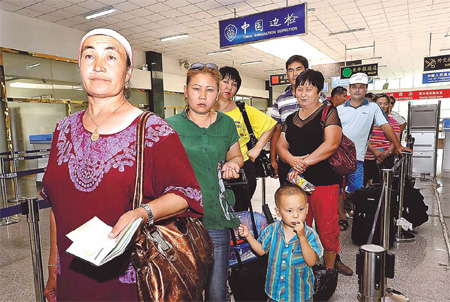
Kazakhstan-China Transportation Opportunities and Challenges
Publication: Eurasia Daily Monitor Volume: 9 Issue: 35
By:

At the end of November 2011, PRC Vice Premier Zhang Dejiang and Kazakhstani Minister Aset Isekeshev attended the inauguration of the construction of the first transnational free-trade cooperation center in Central Asia, located along the cross-border river near the Xinjiang village of Horgos. This China-Kazakhstan Horgos International Border Cooperation Center occupies 3.43 square kilometers (km) of land inside northwest China’s Xinjiang Uygur Autonomous Region and 1.85 square km on the Kazakhstani side. In accord with an agreement signed between China and Kazakhstan in September 2004, the Horgos center will be developed into a “free port” for tariff-free trans-border trade, daily duty-free purchases for visitors, and services to promote mutual investment, trade, financial services, tourism and entertainment. The existing commercial hub at Horgos Port already handled 3 million tons of cargo and 550,000 tourists in 2010. A recently constructed railway passes through the area (https://mcps-khorgos.kz).
During the past two decades, Kazakhstan and China have been developing the infrastructure needed to expand economic ties – creating border posts, energy pipelines, and roads and railways that have converted the informal shuttle trade that arose in the 1980s to a large-scale, professional economic relationship.
In fact, the 460 km line between Urumqi in Xinxiang and Alataw Pass, where it connects to Kazakhstan’s railways, represents China’s only currently operational rail link with Central Asia. In 2009, the Alataw Pass Port became a free-trade zone, allowing Kazakhstani citizens to enter visa-free for one day (https://kazworld.info/?p=5249).
The increased transit capacity with Kazakhstan should allow China to import copper from the major Boschekul border deposit, whose development will presumably be financed by some of the $2.7 billion China’s Development Bank lent to Kazakhmys, Kazakhstan’s largest copper producer. The field, located in northern Kazakhstan, could produce 12.5 million tons of copper annually in a few years (Astana Calling, January 5, 2010).
China is also financing construction of a second railroad to Kazakhstan that links Horgos with Zhetygen (Kazakhstan Times, June 14, 2010). It spent 300 million yuan (approximately $44 million) to build nine broad gauge rails (Russian standard) and six standard gauge rails to the Alataw-Pass. This increased volume will allow for the importation of 50,000 tons of Liqufied Natural Gas (LNG) this year and 200,000 tons of LNG in the next three years (MetalNewsNet, June 17, 2010).
On June 14, 2010, a freight train carrying 45 tons of LNG crossed the Chinese-Kazakhstani border at the Alashankou check point en route to delivery to the Dushanzi petrochemical plant located in northern Xinjiang. The shipment marked the first time that China imported energy resources from Central Asia by rail (Journal of Turkish Weekly, June 16, 2010).
In 2011 a new Saule train began transporting containers along a 11,000-kilometer route from China’s city of Chun Zin to Europe’s largest port of Antwerp via the territories of Kazakhstan, Russia, Belarus, Lithuania Poland, and Germany (Trend, Nov 12, 2011).
Both countries are major players to the 8,700 km China-Western Europe highway under construction. Once completed in late 2013, containers will take just 15 days to move from China’s eastern seaboard to Europe, three times faster than if they went by sea. More than 30,000 Kazakhstani workers are helping construct a 1,734 km stretch that passes through four of regions of Kazakhstan (Aktobe, Kyzylorda, Zhambyl and South Kazakhstan). President Nursultan Nazarbayev called the highway the “construction of the century” in his January 27, 2012 State of the Nation address (Ministry of Foreign Affairs website, January 27).
Yet, much additional progress is needed in this area to achieve the higher levels of bilateral commerce sought in both Astana and Beijing. When Kazakhstani Prime Minister Karim Masimov met with Chinese Premier Wen Jiabao on April 9, 2008, Masimov stressed Kazakhstan’s commitment to enhancing bilateral commerce through infrastructure development, specifically citing the need to improve Kazakhstan’s ports, customs and banking systems, railways, highways and other commercial networks involving China (Ministry of Foreign Affairs of China,” April 9, 2008).
In addition to the underdeveloped economic infrastructure connecting the two sides, other impediments to expanded commercial exchanges include unsupportive visa policies, special regulations on Chinese consumer products, corrupt commercial practices in both countries, and Kazakhstan’s non-membership in the WTO.
Kazakhstan’s close economic ties with Russia also have disrupted some Sino-Kazakhstani economic ties. On the one hand, much Russia-China trade goes through Kazakhstan (PONARS Eurasia Policy Memo, 2012). On the other hand, Russia has sought to prevent the newly implemented Russia-Kazakhstan-Belarus Customs Union from serving as a backdoor for the smuggling of cheap Chinese goods into Russia by pressing Kazakhstan to tighten controls at the Kazakhstani-PRC border before Russia and Kazakhstan eliminated their joint border checkpoints (EurasiaNet, May 5, 2011). Some Kazakhstanis complain that they can no longer buy cheap Chinese imports but must now spend more to buy often inferior quality goods from Russia and Belarus. Vladimir Putin’s proposed Eurasian Union, which the Kazakhstani government has said they would join, could erect further economic and perhaps other barriers between China and Kazakhstan.




